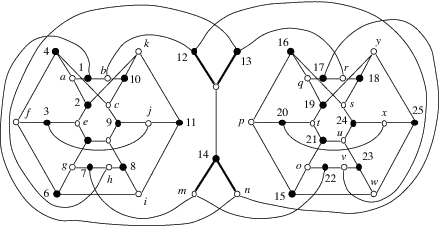Accoring to Wolfram|Alpha, Georges Graph
$\hskip1in$

is 3-edge colorable. Does anybody have a actual 3-edge coloring in form of three sub-matrices of the adjacence matrix: $$A_1+A_2+A_3=A $$
I tried to get them along the lines given here without success...
EDIT: Some further properties of Georges Graph are:
asymmetric | bicolorable | biconnected | bicubic | bipartite | bridgeless | class 1 | connected | cubic | cyclic | local | noncayley | noneulerian | nonhamiltonian | nonplanar | perfect | perfect matching | regular | square-free | traceable | triangle-free | weakly regular
Maybe this helps someone to help me...
Another strategy might be to look for a maximal matching and color it 1, then look for another maximal matching and color it 2, with the remaining edges colored 3.
– Laars Helenius Jan 26 '15 at 23:17